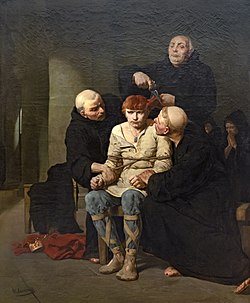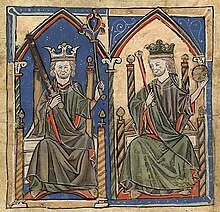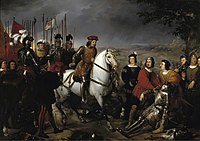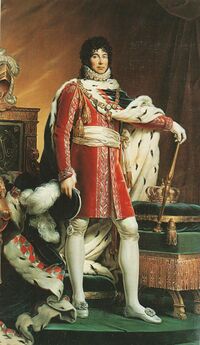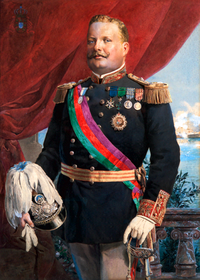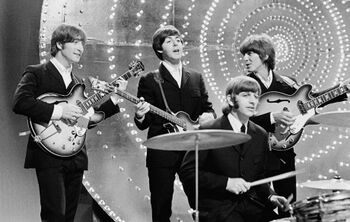Vvarden
This article is incomplete because it is pending further input from participants, or it is a work-in-progress by one author. Please comment on this article's talk page to share your input, comments and questions. Note: To contribute to this article, you may need to seek help from the author(s) of this page. |
Kingdom of Vvarden ... | |
|---|---|
Motto: Hoc hic misterium fidei firmiter profitemur "Here is the mystery of faith that we strongly profess" | |
| Official languages | Vvarden |
| Recognised regional languages | Bevenian |
| Vvardo-Bevenian | Vvardenese, Bevenian |
| Demonym(s) | Vvardenese |
| Government | |
• President | Amaro Piras |
• Prime Minister | Iagu Trudu |
| Establishment | |
• Subjugation of local Veyene and Celtic peoples by the Fiorentine Empire | 50-60 B.C |
• Gautigothic Kingdom established | 523 C.E |
| 851 C.E | |
• Floriana and Lustainu | 1214 C.E |
• Union of Portucaria and Lugonia | 1444 C.E |
• Loisine War | 1802 C.E |
| 1895 C.E | |
| 1923 C.E | |
| 1934 C.E | |
| 1989 C.E | |
| Population | |
• Estimate | 32,000,000 |
• 2018 census | 31,812,420 |
| Currency | Vvardenese Rial (VR) |
| Date format | dd ˘ mm ˘ yyyy |
| Driving side | left |
| Internet TLD | .vvr |
Vvarden, officially called the ... (Vvardenese: ...), or also known as the ..., is a ... on the continent of Asura located within Aeia. The official language is Vvardenese, which is spoken by approximately 80 million people worldwide.
Vvarden is considered to be a regional or secondary power in Asura and in Aeia, due to its central position in Western Asura despite its relative obscurity in recent years. Vvarden performs well in international rankings: it is 12th in quality of life, 15th in Good Country Index, 13th in inequality-adjusted human development, 19nd in the Social Progress Index, 20nd in Global Innovation Index and ranks as the 10th safest country in the world. Well known for its rich cultural history, Vvarden has contributed significantly to arts, music, literature, sports and science and technology. Vvarden is the 5th most popular country as a tourist destination in Asura, attracting 24.3 million international tourists in 2017. Vvarden's capital, and its largest city and metropolis is Betanzos, a significant economic hub which has been classified as a major city on the continent of Asura.
Modern humans first arrived in Vvarden around 35,000 years ago, and developed neolithic cultures. Vvarden came under Fiorentine rule around 200 BCE, and was not fully conquered until the end of the first century AD. Previous military expeditions to subdue the eastern tribes, such as those of Marcus Cornelius Gallicanus, and Aelius Magnus, had mostly ended in failure, making the Fiorentines content to hold onto more developed areas. As such, there was not a lot of Fiorentine cultural influence inwards for at least some time, preserving the local Marric language of the region. From AD 47, three years after the ascension of Emperor Nero, grandnephew of the first emperor Gaius Claudius Caesar Augustus, the rest of Vvarden was slowly conquered, with the Fiorentines settling many colonies, most notably Colonia Victricensis with its large Temple of Nero, the largest of its type in the western half of the country. The conquest was finally completed by AD 96, but even then there remained loose pockets of resistance and some rebellions, particularly in the highlands around ... .
At the beginning of the fifth century, the Fiorentine Empire led by Sebastianus abandoned the province in response to the increasing threat faced by eastern Germanic migrations. These Vvardenese cities, which were told to organise their own defences from resurgent Marric invaders sweeping south, as well as from invading Germanic groups, began to fragment among tribal lines, becoming separate kingdoms in their own right. Germanic groups, like those of the Gautigoths and Taifals, invaded and managed to unite a majority of Vvarden by the 7th century under the Amalic Kingdom, but were quickly assimilated into the local Fioreno-Marric population. Over the next few hundred years, the ethnic distinction between the indigenous population and the Germanic invaders had mostly dissipated; the Gautigoth language consigned to the declining function of a church language at the time of the abolishment of different laws for Allamanic and Vardene peoples in 654. The nobility of the Amalic Kingdom, in particular the Mayors of the Palace, slowly gained power from the monarchy and from one another, turning them into little more than figureheads. Eventually the reign of the Amalic dynasty came to an end when one of the Mayors of the Palace, Vermudo de Lugones, removed the figurehead King Gandolfo, establishing the Kingdom of Lugonia.
With the forced abdication of King Xoán II of Lugonia by his sons in 1138, the Kingdom of Lugonia split into three separate kingdoms of Floriana, Lusitaina and Albeona. The three kingdoms were eventually reunited in 1324 (Floriana and Lusitaina in 1214, Albeona later) under a recreated crown of Lugonia. In 1444, the crowns of the kingdoms of Portucaria and Lugonia were united by the marriage of Xabela I of Portucaria and Lois III of Lugonia. This act of union, however, was a union in title only, as each region retained its own political and judicial structure. However, when the throne of both realms passed to Lois' grandson Xaime I in 1453 upon Lois' death, the two were officially merged into the newly created Kingdom of Vvarden.
After the unification of Vvarden, sailors began exploring the west coast of Arabekh and Majula, with the first voyages occurring around 1418-1419. Using recent developments in navigation, cartography and maritime technology such as the caravel, Vvardenese explorers discovered parts of Rennekka and Vestrim, setting up a great many trading posts and fortifications to secure the route to Yidao. During this time, Vvarden monopolized the spice trade, and the empire expanded with military campaigns in Yidao. Vvardenese prominence increased further with the death of King Xaime II, in 1530, which led to a personal union between Vvarden and ... . In 1620, a revolt spearheaded by prominent nobles brought King Xoán V de ... to power, ending the union with ... .
Vvarden was plagued by dynastic conflicts in the latter half of the 18th and early 19th century culminating in the Loisine War, fought between the autocratic claimant to the throne, Lois V, and his nephew, Payo VIII who supported ideas of constitutionalism. The victory of Payo VIII in the Loisine War led to a fracturing among monarchists between Loisines and Marians. Loisine sympathies in many echelons of the government, and in certain conservative areas of Vvarden would lead to great tensions and bitter fighting. The Marian line was deposed in 1920, after the King was baited into halting democratically agreed on institutions by republican politicians, giving them a reason to depose the King. After the 1920 revolution deposed the monarchy, the democratic but unstable Republic of Vvarden was established. However, tensions between authoritarian and conservative groups favouring the return of the monarchy, and democratic, socialist, communist, and liberal groups that wanted Vvarden's liberal experiment to continue grew over the next half-decade, eventually culminating in the Vvardenese Civil War. The fighting was bloody and violent across Vvarden, with the Republicans gaining the upper hand. Those that had supported the monarchy fled to Vvarden's colonies to set up a Vvarden-in-exile. Radical communist and socialist groups that fought for the Republic conducted a coup, purging many anti-communist elements from Vvarden and instituting a dictatorial Democratic People's Republic of Vvarden.
In 1956, due to long running political repression, food shortages, a stagnant economy, and failed reforms, protesters backed by the military overthrew the dictatorship. In the following months, the Vvardenese government-in-exile was absorbed back into Vvarden and many conservative, monarchist, and reactionary elements returned to Vvardenese society. After much deliberation by the military junta, the Provisional Union of Vvarden was established three months after the revolution in order to stabilize the country and pave the way for whatever party the people would decide on. The new democratically elected conservative government decided to appease monarchist sympathies by restoring the King, this time the claimant from the Loisine line, the Prince of Marauçan, Lois de Bragantinu.
As the Vvardenese Integralist Party gained power, more powers were given to the King to appease them. In 1961, several weeks before the second elections, the King dissolved parliament, placing Integralist ministers and party members in the high eschelons of his cabinet, thus bringing the Integralist Party into power. There had been tensions not long afterwards between Integralist leaders and King Lois VI as the King sought to align himself more as a traditional absolute monarchy rather than fully following to the Integralist system. When King Lois VI died on the 9th of November 1993, his son Prince Ramon came into power as Lois VII, who unlike his father, had fully embraced the Integralist system. Since then the government has been practically aligned solely to Integralist interests, although the proposed reforms of the Crown Prince Aurelio, may threaten these interests, primarily due to his long-running rivalry with the leader of the Integralist party, Xoán-Alexandre do Pereyro.
Vvarden has left a profound cultural and architectural influence across the globe and a legacy of ... million Vvardenese speakers, especially in former colonies and current possessions of Vvarden, from which many Vvardenese-based creoles exist.
Etymology
The origin of the term "Vvarden" is highly debated. Some have stated that it originates in proto-Foranic artodunom, meaning "Bear-Fort", which became corrupted with the Gautigoths into Waradun, which became "Varden". Other scholars of the proto-Foranic origin for Vvarden's name have instead proposed wailodun meaning "Wolf-Fort" as the origin. There are those who believe it has a root in the proto-Alemannic walhaz or "foreigner", wada or "ford", or wardana meaning "protector"; combined with denaraz meaning "palm" or "flat", or even the Foranic "dunom". Others have completely rejected either school, stating it has a Fiorentine or even a pre-Sifharo-Asuran origin.
History
Prehistory
Vvarden was inhabited, first by Homo erectus, then by Homo Glenmorensis. Archaeological findings from caves in the Cerbantian mountains reveal that Vvarden was populated by hominids at least some 1 million years ago. Modern day humans are believed to have arrived from the east around 36,000 years ago, leaving behind cultural items such as cave paintings like those in ... . Vvarden is believed to have been one of the major refuges for early human populations within Asura during the ice age, and findings show the peninsula was relatively populated and lively. In the Mesolithic period, a native culture developed, that of the Asturiense, and later, with the introduction of the Bronze Age, megaliths and tumuli were constructed. In the Iron Age, the territory came under the cultural influence of the ...; the local ... peoples, known as the ..., were composed of tribes such as the Luggones, the Pesicos, and others, who populated the entire area with castros (fortified hill-towns).
Pre-Fiorentine Period
Fiorentine Empire
Vvarden was ultimately completely conquered by the Fiorentines over a period of two hundred years, and managed to continue control of it for another six hundred, bringing Fiorentine influence. This influence had a profound impact on the cultural and linguistic nature of Vvarden. The west became densely populated with Fiorentine speakers, assimilating the native ..., unlike the more rustic and sporadically controlled centre and east, controlled by the ... . This enabled the ... language to survive and evolve into modern ..., albeit not without significant influence. Fiorentine rule was cemented through constructs such as roads, and bindings such as their laws. For most of the Fiorentine period, Vvarden acted as a granary for the empire, exporting olives, wool, gold, iron, lead, and wine across the empire. Agricultural yield boomed thanks to irrigation projects, like aqueducts, which still remain today in many parts of Vvarden. The Fiorentine Emperors ..., ..., ..., Lugonicus, and ... were born in Vvarden, along with the noted philosopher ... . Vvarden converted to Alydianism after missionaries came in around the 2nd century, quickly becoming popular. These Fiorentine and ... influences went on to define much of Vvarden's later laws, languages, and its religions.
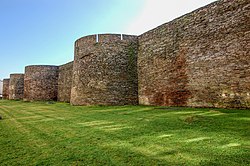
Post-Fiorentine Period
Kingdom of the Gautigoths
Main articles: History of the Gautigothic Kingdom, and Rechimundingi dynasty
The Kingdom of the Gautigoths, also known as the Gautigothic Kingdom, existed in modern day Vvarden between 523 and 851.
Many kings came to the throne at a young age and died in the prime of their lives and before many of them could have children, weakening royal power further. Atanaxildo's descendant, Teodegildo III, who led armies to conquer Lhaeridhic lands and pagan Arzvans in the east, is commonly seen as the last powerful Rechimundingi King. In 820, upon the death of High King Xuntomiro, his lands were divided between his sons Xaudemiro and Xelimiro. An invasion from the north swallowed Xaudemiro's half, and he fled in exile. Over the next few decades, Gautigothic lands shrank to foreign conquests and rebelling nobles until it was reduced to a rump state in the mountains of central Vvarden. In 851, the Mayor of the Palace, Vermudo deposed the last member of the Rechimundingi dynasty, Gandolfo Rechimundingi, tonsuring him and exiling him to a monastery, ending over three hundred years of Gautigothic rule. With the support of the remaining nobility and the blessing of the Pope, Vermudo became the first King of Lugonia.
Middle Ages
In the east, following the example of Gundemaro Mires, Lugonian noble Doncado MacoBriago de Carantos, also known as Doncado Dono or Doncado the Brown, was able to seize several towns in the hilly and mountainous area of ..., crowning himself King of ... in 840. Doncado was a member of a clan who traced themselves back to a legendary Fiorentine noble by the name of Arcado Dubo who remained in Vvarden and resisted the Gautigoths.
Around the turn of the 10th century, names from purely ... origins like Vedorcu or Daucale or Malcunu became less common among the ruling classes, replaced by names that had either Gautigoth or Fiorentine origins like Ricmeru, Alfonsu, Remanu, and Vernandu. The name change reflects the increasingly changing nature of Vvarden entering the High Medieval Period, as influences from nearby Fiorentine-culture slowly replaced many aspects of traditional ... culture.
The situation in Vvarden became increasingly complex and divisive by the time of the arrival of the Normaunds in the early 11th century. In 1007, Normaund pilgrims started travelling to Vvarden. They travelled in order to pay homage at certain holy sites, such as the Temple of St. Landus at Carnu, and the Monastery of St. Dimas on Monte Vindu. Others travelled to Vvarden as mercenaries, led by brothers Robert and Enguerrand de Brai, descendants of the legendary Boso de Brai. The brothers so distinguished themselves in service to Lugonia in the War of Brigantia that King Nepoxano gave them the frontier counties of Esarno, Eiras, Brega and Tirtocu in 1012. King Nepoxano had hoped to appease the issue of Normaund immigration into Vvarden by giving them a rural, impoverished, area to settle in, one devastated by recent wars. Nepoxano also hoped that the Normaunds could also act as a buffer when Celts would regain their strength and raid Lugonia. Contrary to his expectations, Robert, Enguerrand, and a third brother Vauquelin, who travelled to join them in 1013, were able to rebuild and fortify the area using advanced construction techniques picked up in their time in Mydroll, fortifying the land with many castles. The Brothers de Brai as they became known, quickly established themselves as powerful vassals of King Nepoxano, able to influence Lugonian politics to a large degree.
Shortly after, in 1511, ... and ... were united in the Pact of Wernimes-Ogrobis, and their son Searles I combined the two kingdoms into a United Kingdom of ... .
Iberunian Empire
Liberalism and Searlesianists
The first ... king of Iberunia ..., claimed both his right to the throne and authority came from God, or divine right. This concept in many ways provided a justification for increasing centralisation, which continued until the end of the dynasty. This centralisation in many ways brought the monarchy into conflict with much of the aristocracy, many of which could trace their lineage back to feudal times.
Other issues increasing tensions included the shrinking proportion of land owned by ethnic ..., two centuries of mismanagement following the 1511 Union, and religious differences between the ... ... and the ... ... and ... .
Nineteenth Century
Loisine War
On his deathbed in April, 1802, the childless King Antine explicitly asked for the throne to pass to his neice, the Princess Maria de Bregantinu, who in his mind had proved herself a capable heir to the throne. However, there was another claimant in the form of the absolutist Lois de Bregantinu-Wisardi, Maria's brother, who rejected Antine's choice as heir. Many of Lois' supporters were alarmed by the liberal reforms that had been initiated across most of Western Asura, inspired by similar changes in Midrasia, and had rejected compromises for constitutional monarchies. The increasing deadlock between the two sides in the weeks after Payo VII's death was forced open when Maria became crowned Maria II on May 4th, 1802. As a result, militias loyal to Lois, who claimed the title of Lois V, rose up in reactionary and conservative areas of Vvarden.
The war fundamentally split the House of Bregantinu into two lines: the Marian Line, or the House of Bregantinu-Agramont, and later Bregantinu-Agramont-Osraige; and the Loisine Line, or the House of Bregantinu-Wisardi.
Twentieth Century
The Great War
King Payo’s regime was racked with difficulties in the aftermath of the Great War while Payo himself was faced with different personal tragedies within his life. During the Great War, his youngest brother Lois-Felip was killed during the Battle of Alfoz. In 1911 his wife and the Queen of Vvarden, Queen Uxía was assassinated by a Bevenian anarchist and in 1914 his eldest son and heir to the Crown of Vvarden, Crown Prince Lois, committed suicide in the mysterious Allariz Incident. In 1919 his remaining son and heir, Crown Prince Payo was assassinated at the Praza das Igrexas in Vvarden's capital with Payo himself wounded by the assassin. The deaths of most of his immediate family affected his reign and the political atmosphere around the crown, with many politicians calling into question both his family line and the survival of the monarchy.
There were several reasons as to the downfall of the monarchy and the installation of a republic: Since the Loisine War in the early 1860s, autocratic support had chipped away at the legitimacy of the constitutional monarchy, with followers of the reactionary Loisine line opposing them at every turn; Growing government ineffectiveness, especially during the Prime Ministerships of Samuèli Araimmund de Isorna, and Lino Pau Seddori, turned the opinion of those in the government against the monarchy, which had failed to curb such excesses; The marriage of Payo X to the unpopular Princess Gwenfrewi Gwallteuraidh of tir Lhaeraidd who many thought was a spy, had not fully converted to Alydianism, or had arranged for the secret conversion of Payo to paganism; That when Vvarden did solve the issue of intervention with the advice of the monarchy in the First Great War, dreams of territorial ambitions on behalf of the Concordat were crushed with demands for repatriations in the aftermath; Finally the deaths of Payo's heirs meant that if Payo were to die, the throne would pass to a member of the Loisine line, who would undoubtedly seek to impose autocratic rule, thus a republic began to be seen by many as a necessary evil to protect Vvarden from an absolute monarch.
Civil War and Second World War
Post-War Liberalisation and Ovalleism
Contemporary Vvarden
Geography
Climate
Fauna and flora
Politics
Government
Foreign relations
Military
Economy
Automotive industry
Agriculture
Tourism
Demographics
Urbanisation
Peoples
Minority groups
Immigration
Languages
Religion
Culture
World Heritage Sites
Literature
Philosophy
Art
Cinema
Music and Dance
Various regional styles of folk music abound across Vvarden, ranging from ..., to ... styles, to ... . Pop, rock, hip hop and heavy metal are also popular. One of the most popular musical groups of the 20th century, the Otters or "Em Duruhus" originated in Vvarden and quickly spread worldwide, changing the face of popular music and reaching almost a billion units sold internationally by their breakup in 1972.



